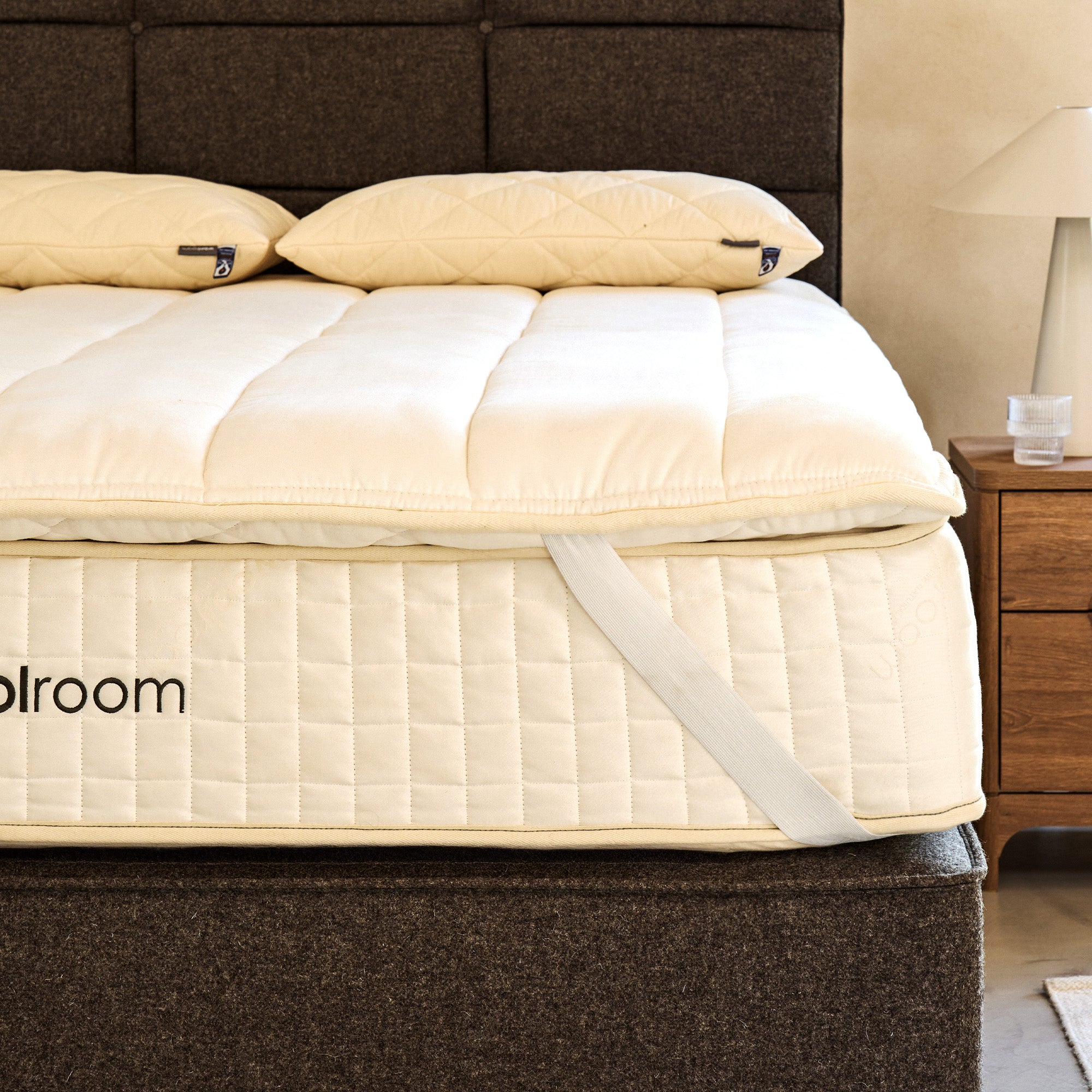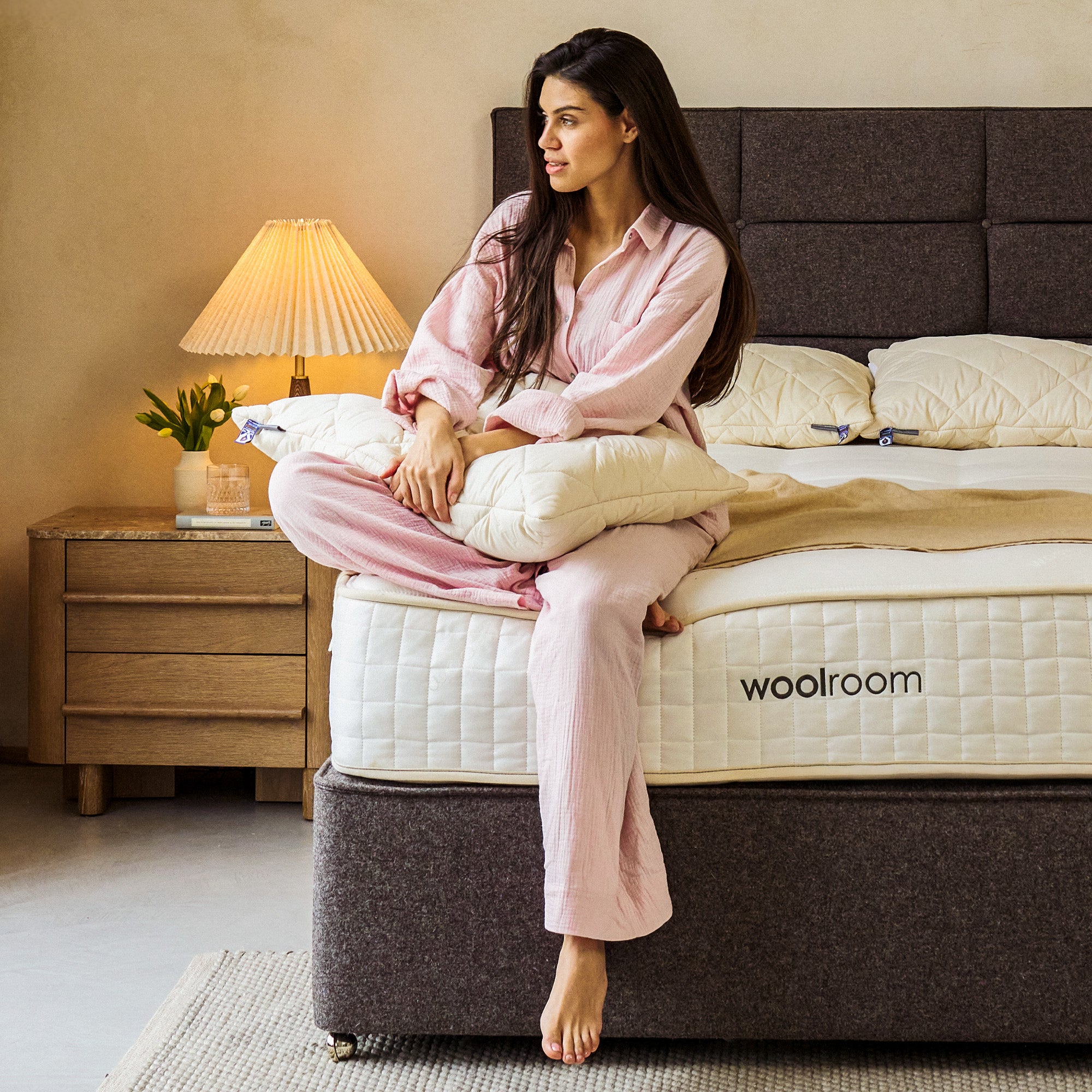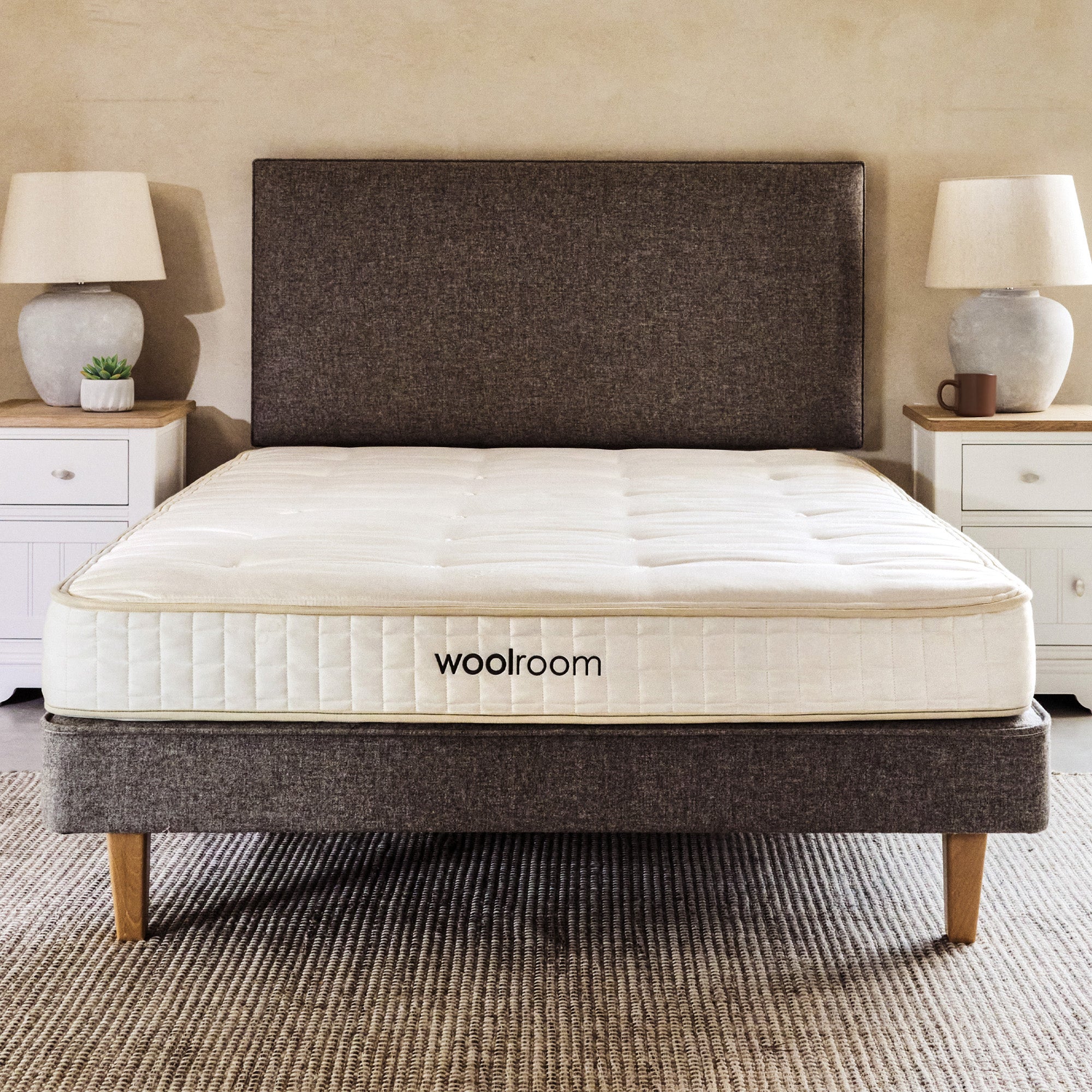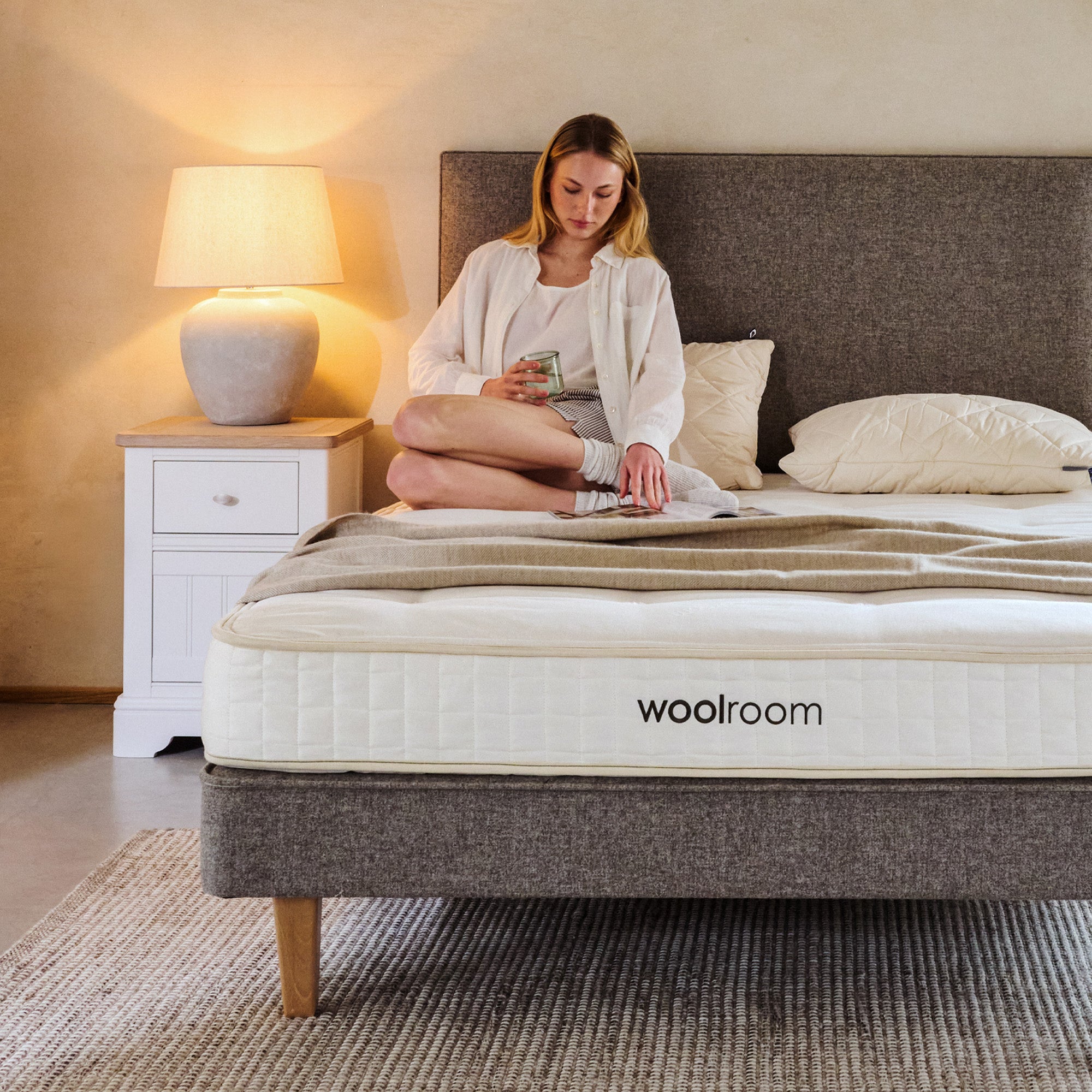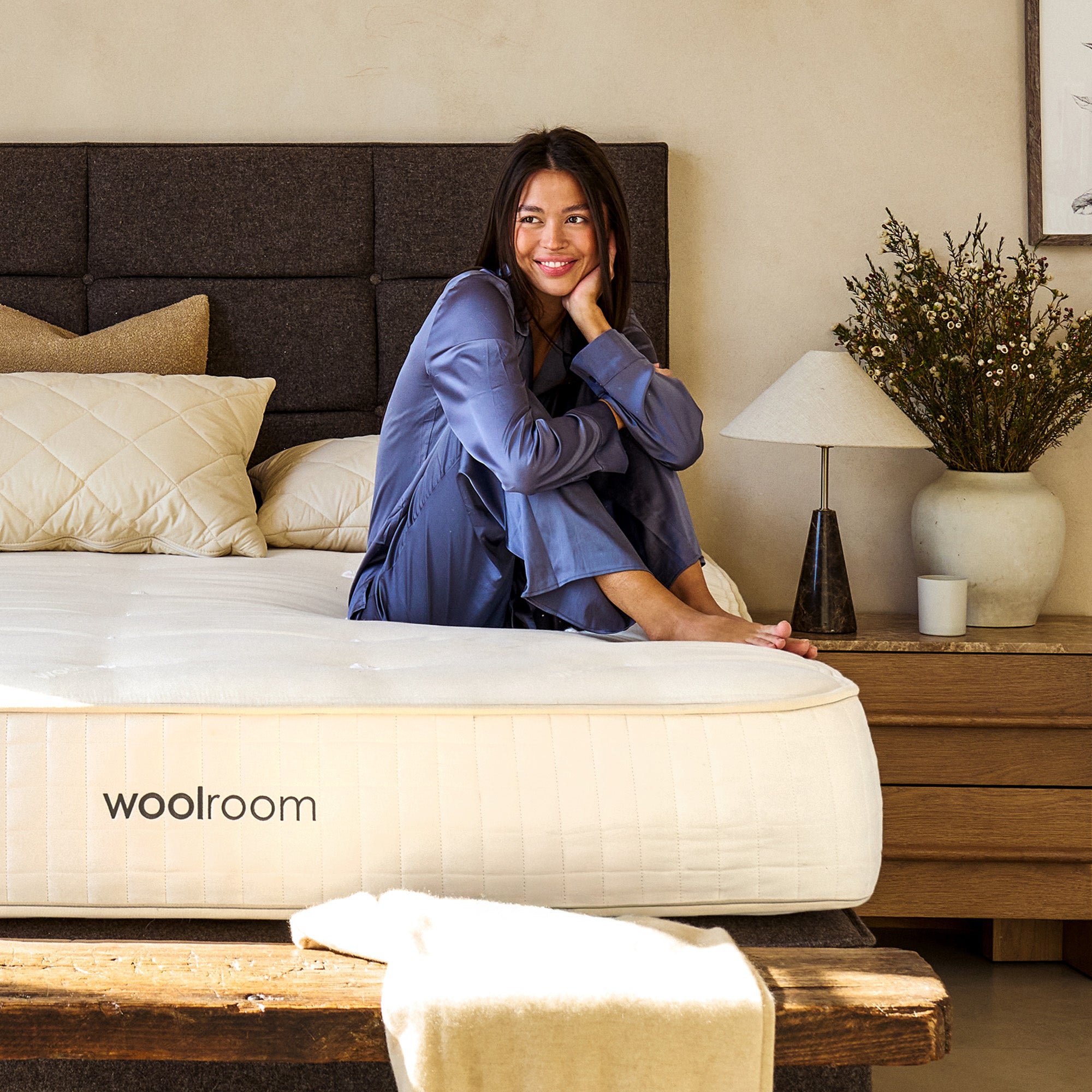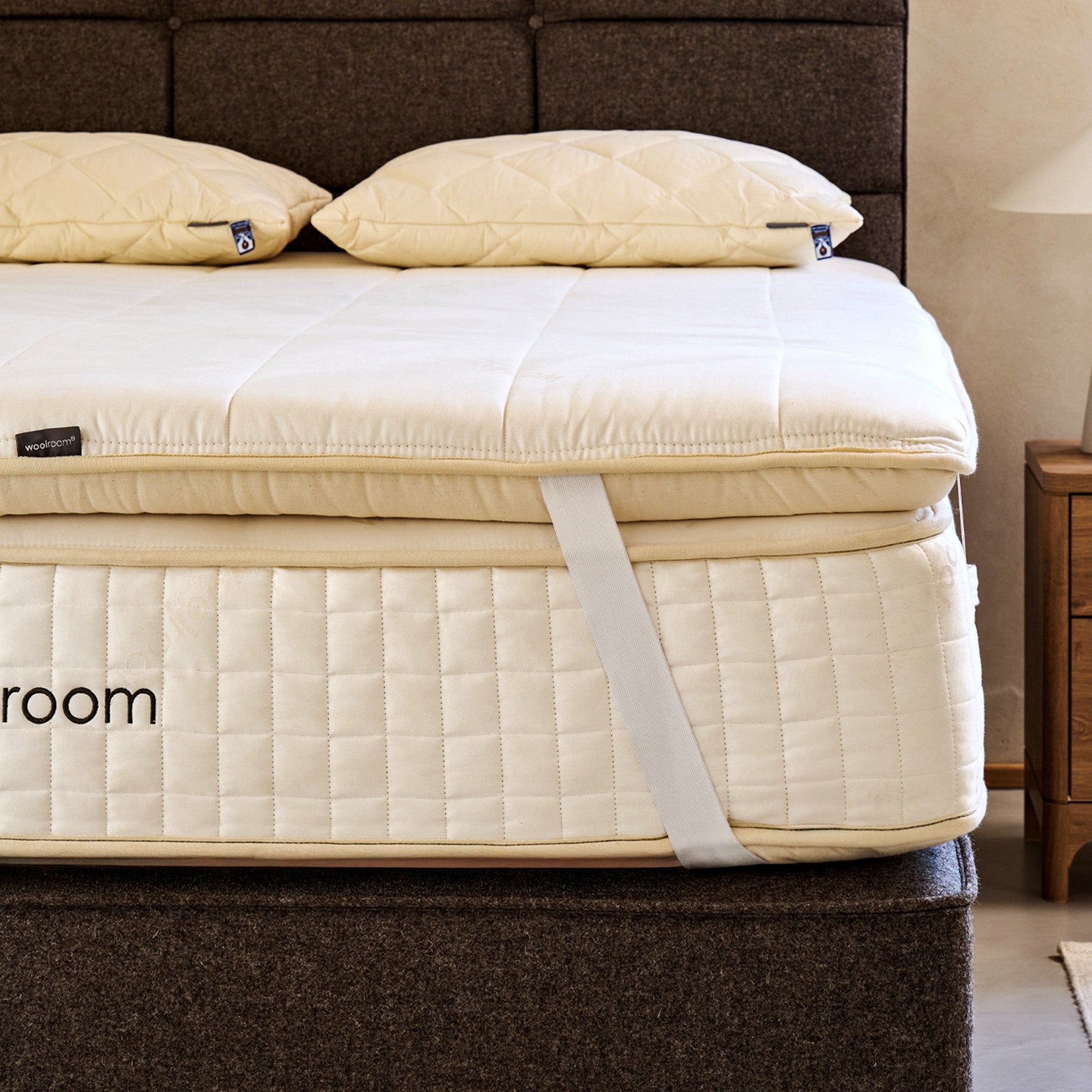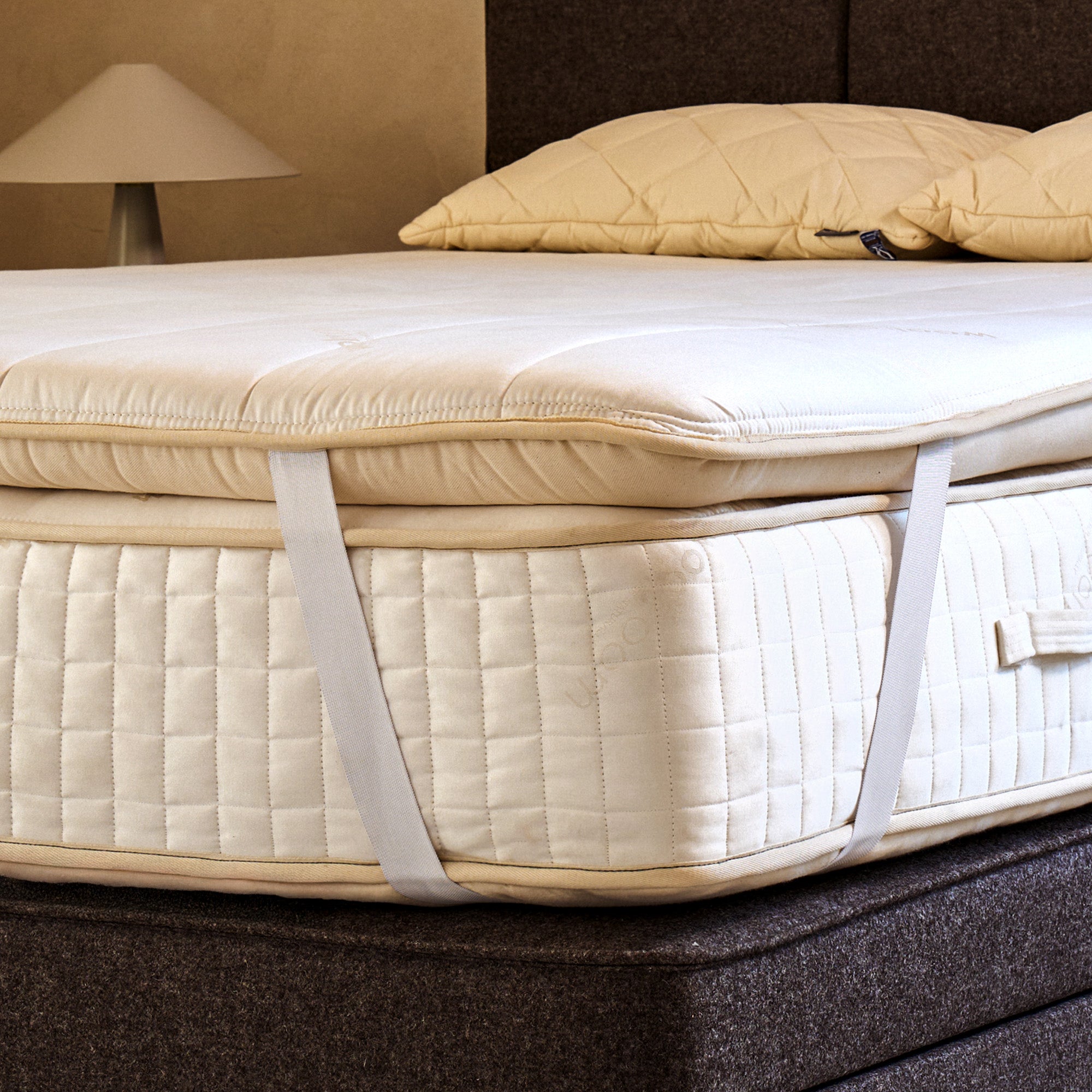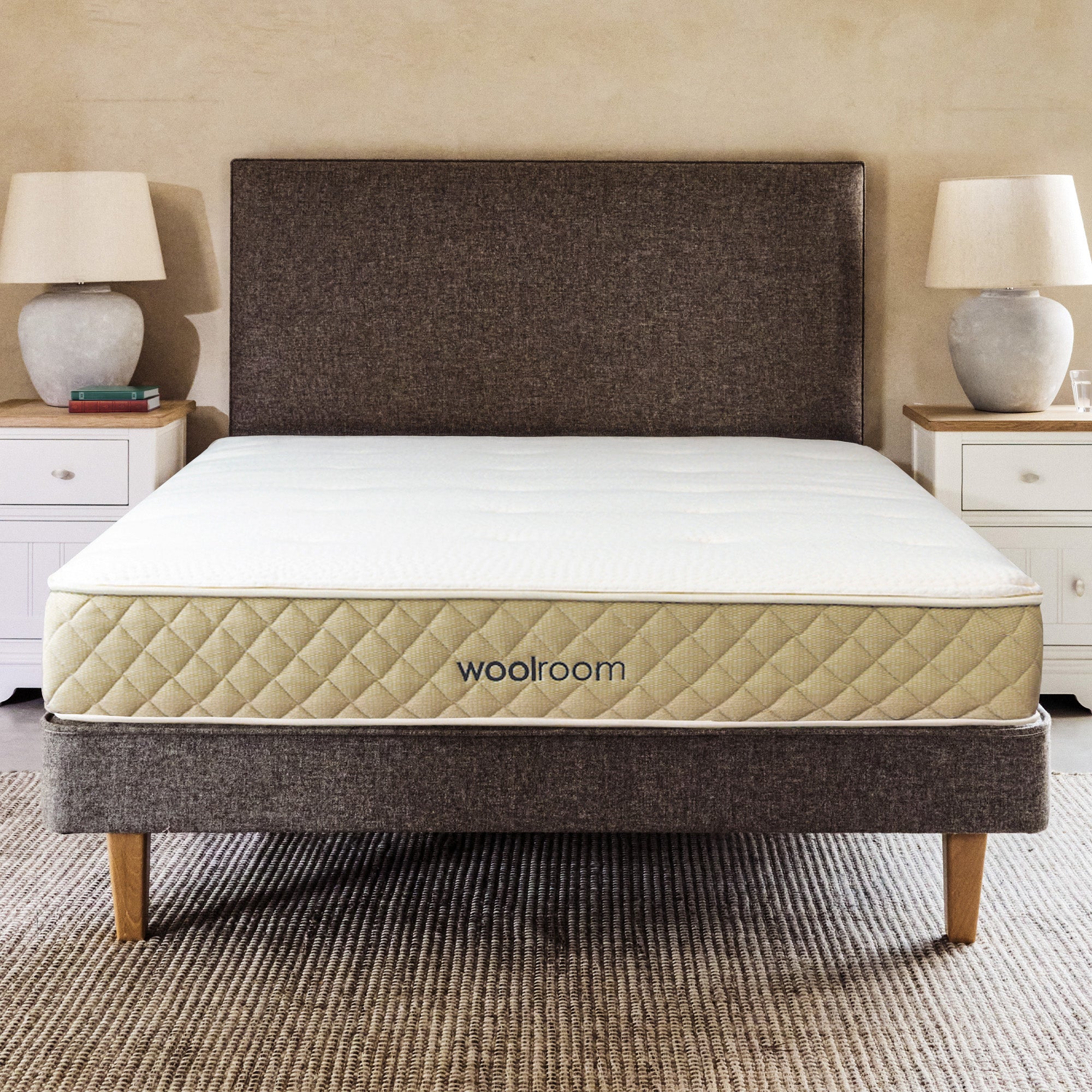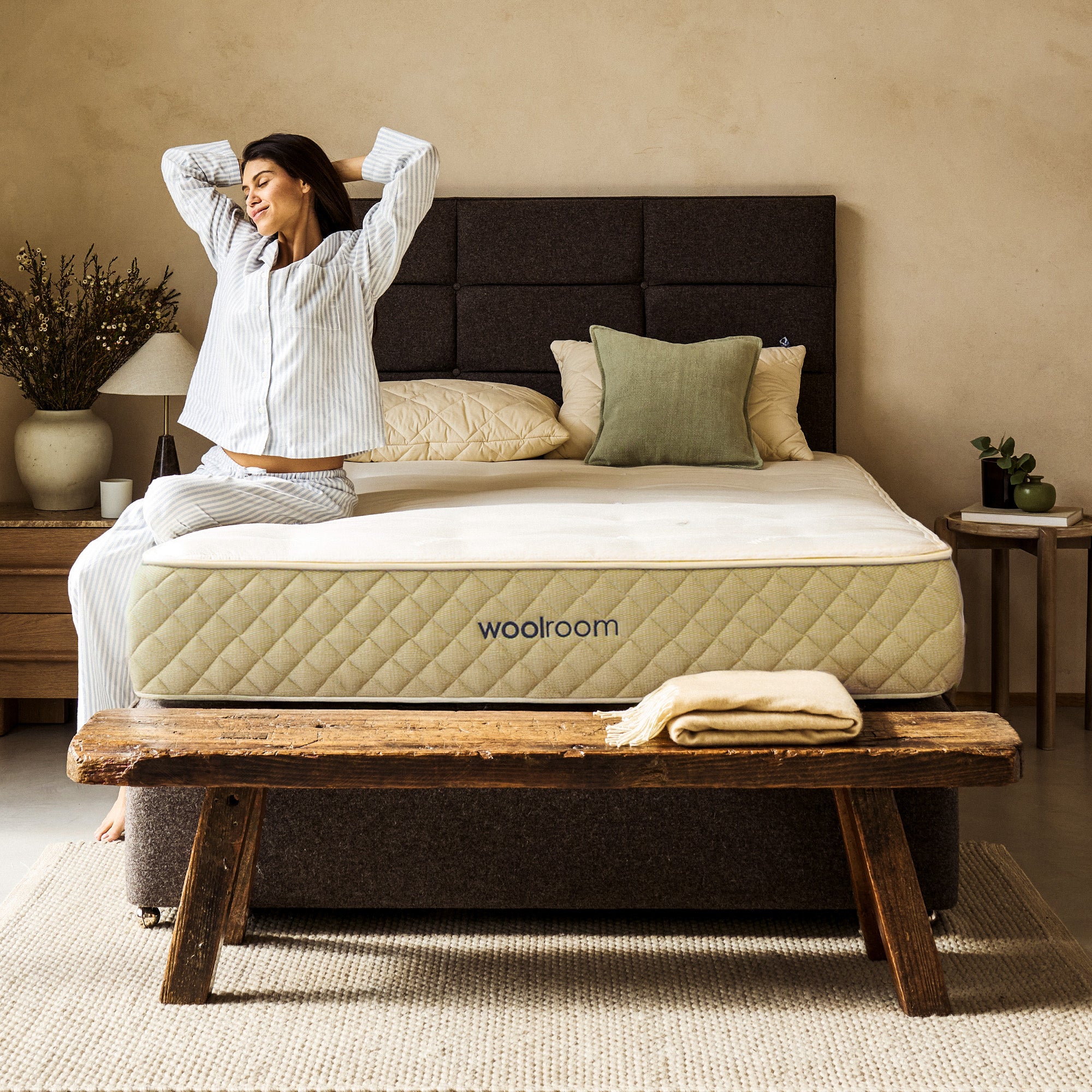If you’re researching mattress materials for better sleep, your options can be sorted into two categories: synthetic and natural. If a mattress is made with any type of polyurethane foam—and that’s most of the bed-in-a-box models—you’re looking at a synthetic mattress. If it’s made with naturally sourced materials like wool in lieu of synthetics, it falls into the natural mattress category.
But in the wool versus foam showdown, which material is best for your sleep? Based on the sheer number of synthetic foam mattresses on the market, you might assume these beds do the trick. Unfortunately, availability isn’t a reliable indicator of quality, and your sleep is far too precious to risk on a mattress that doesn’t contribute to healthy, restful nights. Here’s what to understand about wool versus foam in the battle of the beds, what you’re risking by sleeping on synthetic materials, and why organic wool is a vastly superior choice for better sleep.
Understanding Wool and Foam in Bedding
In the US, mattresses are typically crafted of several layers to deliver varying degrees of support and comfort. These layers can be made from varying materials, and polyurethane foam is a big one. It’s cost-effective to mass produce mattresses made with variations of this material (like memory foam and even proprietary “eco foams”), which is why they’re so easily found online and in mattress showrooms around the country.
At the other end of the spectrum from these synthetic mattresses are those made entirely of natural materials, including wool, cotton and latex. In particular, wool is an incredibly versatile material in a mattress. Its innate characteristics translate particularly well for healthy, comfortable sleep.
What is Wool?
Wool comes from sheep, which spend the coldest months growing a wooly fleece to protect against the elements. In the spring, sheep are sheared to ensure their comfort and well-being. The process is cyclical and fully sustainable. It’s supported by Mother Nature herself, requiring only grass, sunshine, fresh air and rain.
As a fiber, wool is truly in a league of its own. Naturally renewable, biodegradable and recyclable, it’s one of the best bedding choices you can make from a sustainability perspective. But the fiber also has properties that directly contribute to comfort for more restful sleep, something we cover in more detail below.
What is Foam?
Polyurethane foam, also known as polyfoam, is a petroleum-based material used for both cushioning and support. It’s one of the most inexpensive materials you can use in a mattress—hence its wide availability. Polyfoam can be tailored to specific densities and firmnesses, which gives it a softer or firmer feel. It’s also fairly versatile. You can engineer polyfoam to be cooler than usual, for example, or to have an airier, springier feel.
Differences Between Wool and Foam
While you’ll find wool and foam used in mattresses—and sometimes even in the same mattress—they’re very distinct materials that offer different benefits. In a mattress, it’s important to remember that comfort and support are highly personal and based on individual factors like sleep style and body type. But the innate properties of foam and wool really can make or break a good night’s sleep.
While foam often makes for an affordable bed, there are serious drawbacks to consider in terms of durability, heat retention and environmental costs. Wool, on the other hand, is naturally breathable and temperature regulating, with impressive moisture-wicking and longevity benefits. Here’s how wool and foam compare in a side-by-side comparison.

The Comfort Factor: Which Material Feels Better?
Keep in mind that foam mattresses describe a big range, from low-end polyfoam to high-end memory foam to synthetic latex foam and everything in between. This range of foams means a range of comfort levels. Memory foam, for instance, is designed to respond to pressure and heat for a signature “sunken” sensation as the material slowly molds to the curves of your body. While that tends to deliver impressive pressure relief, it can be a drawback over the long run. Since memory foam responds to pressure, your body can o sink more deeply in areas of deepest compression, like the hips. Depending on how you sleep, that can pull the spine out of alignment and lead to low back pain.
The close contouring can also contribute pretty significantly to heat retention, which is especially problematic if you’re prone to overheating at night. In fact, that’s one of the most well-known drawbacks to the material as a whole. Temperature regulation plays a critical role in sleep quality, so a mattress that traps heat, which typically leads to sweating and restlessness, isn’t ideal.
Other types of foam, like synthetic latex, tend to feel springier and more buoyant. Instead of sinking down into the mattress, the sensation is that of being on top of it. The most inexpensive polyfoams are typically softer but lack the deep contouring of more expensive memory foams.
Wool has a different sensation. It’s soft and plush, a combination that many people associate with luxurious comfort. In a mattress, wool layers add gentle cushioning that lightly conforms to the body, but it’s not comparable to the deep sink of memory foam or the spring of synthetic latex. The fiber is impressively resilient, so it bounces back fairly quickly after being compressed—say, if you roll from one position to another in the night, which makes it a good choice for combination sleepers. Still, it’s more of a rebound than a true elastic-like spring.
Unlike synthetic foam, wool doesn’t trap body heat. Instead, the fiber is a natural temperature regulator, actively managing heat and moisture to manage temperature fluctuations as you sleep. What’s more, wool can absorb up to 30% of its weight in moisture without becoming damp or heavy. It naturally wicks moisture from your body and releases it into the air, keeping your bed fresh and dry. That means fewer sleep disruptions and a much cleaner sleep surface—an important consideration if you struggle with nighttime allergies.
Health and Safety: Which is the Healthier Choice?
Because it’s derived from petroleum, mattresses made from polyfoam mean you’re exposing yourself to chemicals, volatile organic compounds (VOCs) and isocyanates among them. Both chemicals off-gas, meaning they’re emitted into the air that you breathe while you’re sleeping. Both chemicals are associated with health risks, including respiratory issues, skin and eye irritations, allergic reactions, headaches, dizziness, and more, and it may be even worse if you’re prone to allergies or sensitivities. Some brands attempt to minimize the issue by recommending a set period of time to “air out” your brand new mattress, while others use foam curing techniques. But the fact remains that sleeping on these materials means exposure to chemicals known to cause health issues.
Conventional flame retardants and synthetic adhesives and fabrics also up the ante for chemical exposure. Not only are they problematic for your health, many of them are toxic in the environment—and far too many of these mattresses ultimately end up in the landfill.
Wool sidesteps all of these issues. It’s a natural flame retardant, which means mattresses made with wool can meet flammability standards without the use of toxic chemicals. Wool is also naturally hypoallergenic because it so effectively manages temperature and moisture. That makes it inhospitable to allergens and irritants like dust mites, mold and mildew, which tend to thrive in the moist environments created by synthetic foams.
At Woolroom, our organic wool mattresses are crafted without hazardous chemicals of any kind. We have no need for chemical flame retardants and we don’t use synthetic additives. Instead, we rely on natural scouring and processing methods with gentle, non-toxic detergents to remove impurities and lanolin. It’s a chemical-free way to ensure our organic wool is as good for you as it is for the planet.
Sustainability and Environmental Impact
According to the Mattress Recycling Council, an estimated 15 to 20 million mattresses are discarded every year in the US—that’s an average of 50,000 each day. Far too many of those are made with synthetic materials like polyfoam that leach toxic chemicals into the environment. But the environmental toll from polyfoam mattresses really begins at production. Manufacturing polyfoams often requires a lot of energy, which means greater carbon emissions, while the chemicals used and created during production pose a risk to workers.
Wool doesn’t pose the same sort of sustainability and environmental impacts. It’s truly the most eco-friendly mattress material you can buy, especially when it comes from Woolroom. Our wool is from happy, healthy sheep on British farms that abide by the five freedoms in the UK Animal Welfare Act of 2006. Prioritizing animal welfare isn’t simply the right thing to do—it also means we’re sourcing the highest quality wool. Our commitment to responsible sourcing is evident in our Wool ID program, which makes our wool entirely traceable. Plus, our products are certified by the Global Organic Textile Standard, which means they’ve met rigorous standards for sustainability.

Durability and Longevity
Mattress materials can have a direct effect on overall longevity. The more durable the materials, the longer you can expect the mattress to perform. Polyfoam mattresses generally have a lifespan up to seven years. That’s because polyfoam degrades faster than natural materials like wool, which can also contribute to issues with sagging and support.
All-natural mattresses as a whole tend to outlast those made with synthetic materials, and wool tends to do particularly well. This natural material is inherently more durable than foam because of its resilience and elastic properties, which helps it retain its shape. Plus, because wool is resistant to allergens like dust mites, it helps maintain mattress integrity. You can generally expect a wool mattress to last between 10 and 15 years, but it’s important to choose a bed with high-quality wool and a quality construction, which is what you’ll find here at Woolroom.
Wool vs Foam: Which is Best for You?
There really is no single best mattress for everyone. Comfort is subjective and everyone is different, which means the right balance of materials is often quite personal. But on balance, wool mattresses offer clear advantages over those made from polyfoam, especially when it comes to sustainability, durability and overall health and safety. The same is true if you’re a hot sleeper, because wool naturally regulates body temperature and wicks moisture. If you have allergies, its hypoallergenic properties are ideal for creating a cleaner, safer sleep space. And if you’re looking for an eco-friendly alternative to synthetic mattresses, an organic wool mattress is an excellent choice.
It’s possible to find an excellent wool mattress with an appropriate firmness and feel for your body type and sleep style. Here at Woolroom, several models in our Wooly Mattress collection are offered in a choice of firmness to suit your needs and preferences—with zero compromising on support, safety or sustainability.
Final Verdict: Why Wool is the Superior Choice
There’s a lot to love about wool mattresses, even if they don’t yet enjoy the ubiquity of mass-produced foam beds. Wool is a safe, healthy alternative to polyfoam, with sleep-friendly perks like temperature regulation, durability and eco-friendliness. And those traits really do translate to better sleep—studies show that people who sleep on wool enjoy up to 25% more deep sleep compared to those sleeping on synthetic materials. Here at Woolroom, our organic wool mattresses are part of our commitment to sustainable sleep—better for you and better for the planet—so you can rest easy.



